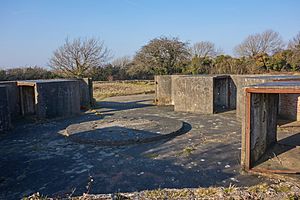Lavernock Battery facts for kids
Lavernock Battery was a fort built near Lavernock Point in Wales. It was constructed in the 1860s to protect important ports in the Severn Estuary. Later, during World War II, a new battery was built there. This new battery had four powerful anti-aircraft guns. These guns were used to shoot down enemy planes.
History of Lavernock Battery
The British government, led by Prime Minister Palmerston, decided to build many forts along the coast. Lavernock Battery was one of these forts. It was the most northern fort in a line of defenses across the Bristol Channel. These forts helped protect cities like Bristol and Cardiff.
The battery was finished in 1870. It first had three large guns called rifled muzzle-loaders. These guns were placed on special carriages that could make them disappear after firing. This protected the gunners. By 1895, a fourth gun was added.
By 1903, all four old guns were replaced. The new guns were two six-inch (152 mm) breech-loading guns. These guns were part of the "Fixed Defences, Severn Scheme." They helped protect ships traveling in convoys during wartime. These ships were gathering or splitting up near Cardiff, Barry, and Flat Holm. Soldiers from the 531st (Glamorgan) Coast Regiment, Royal Artillery operated these guns.
An amazing event happened at Lavernock Point. On May 13, 1897, Guglielmo Marconi sent the world's first wireless message over open water. He sent the message from Flat Holm Island to Lavernock Point. This was a distance of about 6 kilometers (3.7 miles). The message simply said, "Are you ready." Soon after, the equipment was moved to Brean Down Fort. This stretched the wireless range to 16 kilometers (10 miles).
What Lavernock Battery Looked Like
The original battery was shaped like a triangle. It had four places for guns, a protective ditch, and buildings for soldiers. It also had a laboratory and a place to store ammunition called a magazine. Most of the original battery has been taken down. The ditch has been filled in. A swimming pool now sits over one of the old magazines. What is left of the battery is part of a holiday park today.
The Second World War anti-aircraft battery is still in good condition. It covers an area of about 80 by 55 meters (87 by 60 yards). It also had four gun positions for 3.7-inch guns. Each position had a small storage area for ammunition that was ready to use. A larger magazine was located between two of the gun pits. All the guns were controlled from a central observation spot. This spot helped aim the guns and measure distances. This battery is now a Scheduled Ancient Monument. This means it is an important historical site protected by law.


